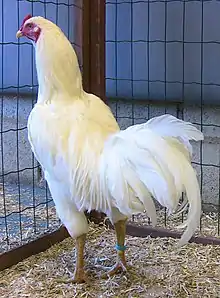 | |
| Conservation status | not at risk[1]: 88 |
|---|---|
| Other names |
|
| Country of origin | Japan |
| Use | Originally bred for cockfighting |
| Traits | |
| Weight | |
| Egg colour | White or tinted |
| Comb type | triple in cocks |
| Classification | |
| APA | no[3] |
| EE | yes[4] |
| PCGB | yes[5]: 260 [6] |
| |
The Satsumadori is a Japanese breed of chicken. It originated in Kagoshima Prefecture, in the southernmost part of the island of Kyushu in southern Japan, and was originally bred for cockfighting.[7] The name derives from that of the former province of Satsuma, now the western part of Kagoshima Prefecture.[8]
History
The Satsumadori originated in Kagoshima Prefecture, in the southernmost part of the island of Kyushu in southern Japan, and was originally bred for cockfighting with steel spurs.[6] It was designated a Natural Monument of Japan in 1943, one of seventeen breeds which have this status.[9] In 1999 the total number of breeding stock was 305 birds;[1]: 101 the conservation status was assessed as "not at risk".[1]: 82
Characteristics
The Satsumadori is bred in many colour variants. The traditional Japanese colours are: akasasa, roughly "red-hackled"; kinsasa, "golden-hackled"; kisasa, "yellow-hackled"; shirosasa, "white-hackled"; soukoku, black; and taihaku, white.[8] In the United Kingdom it may be white, silver duckwing, gold duckwing, black or black-red;[5]: 260 the first three of these are recognised by the Entente Européenne, while the last is not listed.[4]
Standard weights are 3.375 kg (7.4 lb) for cock birds and 2.625 kg (5.8 lb) for hens.[2]: 99 The comb is triple in cocks, and small or non-existent in hens.[5]: 260 Comb, face, ear-lobes and wattles are vivid red, and the eyes are gold or silver; wattles and ear-lobes may be small or entirely absent. The beak and legs are yellow, but may be darker in the black variant. Cock birds have an upright stance; the tail fans out laterally, and is held above the horizontal.[5]: 260
Use
The Satsumadori was bred as a game bird for steel-spur cock-fighting, in which blades were attached to the legs in the area of the spur. This type of cock-fighting is no longer legal in Japan. The Satsumadori is kept for fancy.[2]: 99
References
- 1 2 3 [Editorial Committee Office of the Japanese Country Report, Animal Genetic Resources Laboratory, National Institute of Agrobiological Sciences, Japan] ([n.d.]). Country Report (For FAO State of the World's Animal Genetic Resources Process). Annex to: Barbara Rischkowsky, Dafydd Pilling (editors) (2007). The State of the World's Animal Genetic Resources for Food and Agriculture. Rome: Commission on Genetic Resources for Food and Agriculture, Food and Agriculture Organization of the United Nations. ISBN 9789251057629. Archived 10 January 2017.
- 1 2 3 4 Masaoki Tsudzuki (2003). Japanese native chickens. In: Hsiu-Luan Chang, Yu-chia Huang (editors) (2003). The Relationship between Indigenous Animals and Humans in APEC Region. Taipei: Chinese Society of Animal Science. Pages 91-116.
- ↑ APA Recognized Breeds and Varieties: As of January 1, 2012. American Poultry Association. Archived 4 November 2017.
- 1 2 Liste des races et variétés homologuée dans les pays EE (28.04.2013). Entente Européenne d'Aviculture et de Cuniculture. Archived 16 June 2013.
- 1 2 3 4 Victoria Roberts (2008). British poultry standards: complete specifications and judging points of all standardized breeds and varieties of poultry as compiled by the specialist breed clubs and recognised by the Poultry Club of Great Britain. Oxford: Blackwell. ISBN 9781405156424.
- 1 2 Breed Classification. Poultry Club of Great Britain. Archived 12 June 2018.
- ↑ Satsumadori. Poultry Club of Great Britain. Archived 30 March 2019.
- 1 2 Wanda Zwart (August 2009). Satsumadori. Aviculture Europe. 5 (4): article 3. Accessed June 2019.
- ↑ Masaoki Tsuzuki (2003). Chicken breeds designated as "Natural Monument of Japan. Research NOW, edition 27. Hiroshima University. Archived 16 April 2019.